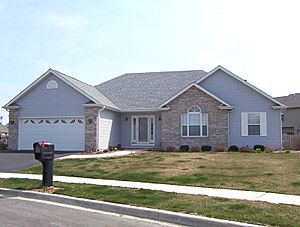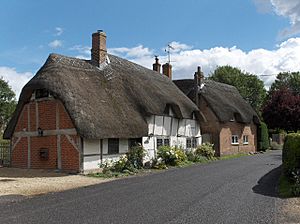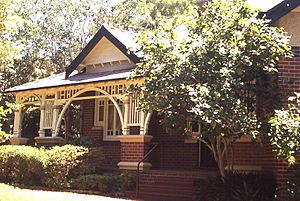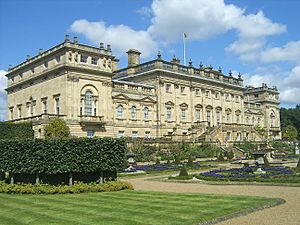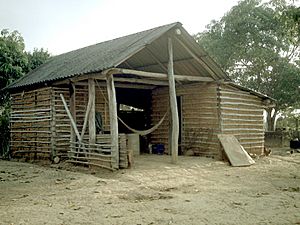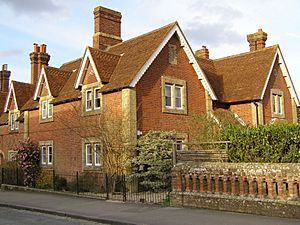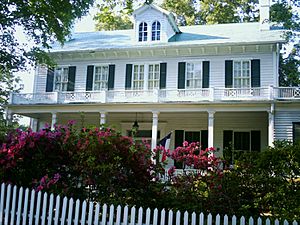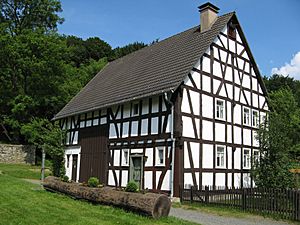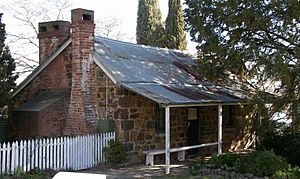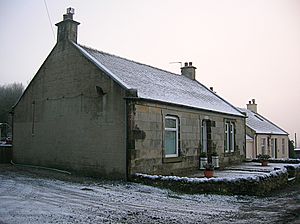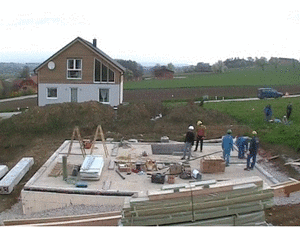House facts for kids
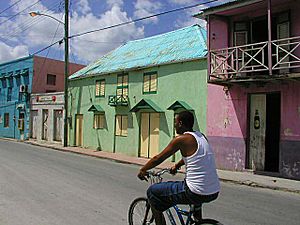
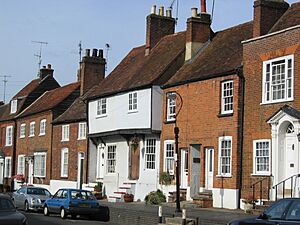
A house is a building where people live. It's a "permanent" building, meaning it's made to stay in one place. It's different from a tent or a caravan, which can be easily moved. When people live in the same house for a long time, they call it their "home".
Houses come in many shapes and sizes. They can be as small as one room or have hundreds of rooms. They might have one level or many levels. Sometimes, houses are joined together at the sides to form a "terrace" or a row of houses. A large building with many levels and separate living spaces is called an apartment block or "block of flats" (in British English). A key difference between a house and an apartment is that a house usually has its own front door to the outside, while an apartment's main door often opens into a shared hallway.
All houses have a roof to protect from rain and sun, and walls to keep out wind and cold. They have windows to let in light and a floor. Houses look different around the world because of the materials used and the building styles.
Contents
Different Types of Houses
A house is a building for people to live in. It is often built for a family (like parents and their children). Most modern houses have special areas or rooms for people to live comfortably. A modern house usually has a place to cook food, a place to eat, places to sleep, and a place to wash. These are often in separate rooms: the kitchen, the sitting room, bedrooms, the bathroom, and the toilet. Many houses also have a separate dining room for meals and a laundry room. Some houses might even have a "study" or computer room, or a "family room" for games and TV.
Detached Houses
In countries like the United States, Canada, Australia, and New Zealand, many families live in a "detached house". This means the house stands alone, separate from other buildings, and often has its own yard. These houses are usually close enough to towns for shops, transport, and entertainment. In many parts of Europe, owning a detached house is often a dream for most people, as it can be very expensive.
Houses in Poorer Areas
In many very poor countries, lots of people live in crowded houses, sometimes with just one room. They often share a toilet with many other families and might cook outside. These houses are often built from materials found nearby, like mud bricks and grass, or from recycled items like corrugated iron and cardboard boxes. In many cities, thousands of small houses are packed closely together, with narrow paths between them.
Cottages
A small house is often called a cottage. In England, where the word comes from, it means a house with one main floor and a lower second floor of bedrooms under the roof. Cottages are usually found in villages or in the countryside. They are almost always built from materials found nearby. In many places, "cottage" means a small, old-fashioned house. In the United States, it can also mean a small holiday home.
Semi-Detached Houses
A semi-detached house is a building that contains two houses side-by-side, covered by one large roof. Each house usually has a path leading from the front to its own backyard. Semi-detached houses are very common in some cities and can have one or several floors.
Terraced Houses
A terraced house (also called a row house) is part of a row of houses joined at their side walls. Many cities and towns have thousands of row houses because they are a good way to build many homes close together. Many old row houses have two rooms downstairs and two upstairs, with a kitchen or wash area at the back. These were often built for factory workers and coal miners. "Terrace houses" are a type of row house where each house looks similar from the front.
Not all row houses are small. Some cities have large, beautiful ones, like the Royal Crescent in Bath, England. It was built 200 years ago and is a famous example of Georgian architecture.
Bungalows
In some places, a "bungalow" is any house that is all on one level. The word comes from India and was first used for houses built on one level with a verandah (a covered porch) where people could sit outdoors in the shade. Bungalows often have a central hall to let breezes blow through. They are common in countries with hot summers, like India, Southeast Asia, South Africa, parts of the United States, South America, Australia, and New Zealand. In areas prone to flooding, bungalows are often built on wooden "stilts" or a high basement. In the 1800s, bungalows were mostly made of wood, but from the 1920s, brick bungalows became popular.
Farmhouses
A farmhouse can look like a cottage, a bungalow, or even a mansion. However, in many countries, farmhouses look different from town houses because they often have spaces for animals as well as people. There are three main types of farmhouses. Many are long and have two doors: one for the family's rooms and another for a stable for cows, sheep, or chickens. The stable part often has a loft for hay. Another type has two floors, with a large stable and storeroom downstairs and the family's rooms upstairs. A third type has the house, barn, and stable all joined around a central courtyard. These old farmhouse styles can be found in many parts of Europe and Great Britain.
Mansions
A mansion is a very large and grand house, usually with two or more floors. Mansions often have beautiful designs and show that the person who built them was wealthy. They usually have lovely gardens. Sometimes, a mansion is not owned by a private family but by a town council, a large company, a church, or a college. It might be a place for an important person to live and host guests. Mansions often have rooms not found in regular houses, like a drawing room, a ballroom, a library, or a music room. They often needed servants to help keep them tidy, with special rooms for tasks like cleaning silver. Famous mansions include the White House in Washington, D.C., where the President of the United States lives, and Mansion House in London, home to the Lord Mayor of London.
Palaces
A palace is an extremely grand house. Palaces are some of the most famous and beautiful houses in the world.
They were often built by incredibly rich people who wanted to show how important their family was. Some palaces took a very long time to build. They have been changed and added to by different family members or owners over hundreds of years.
One of the most famous palaces is Buckingham Palace, where the monarch of England, currently Queen Elizabeth II, lives. The largest palace in the world is the Louvre in Paris, France. It was built for the Kings of France and now holds a famous art gallery.
What are Houses Built From?
Houses are usually built from materials that are easy to find or buy near where the house is built. Because of this, old houses in different towns and villages look quite different, even in the same country. Nowadays, building materials can be moved easily, so builders have more choices for what to use.
Mud and Clay
In many parts of the world, mud or clay are the main building materials. Clay is a type of soil that sticks together better than most others. There are three main ways to build walls with mud and clay:
- One way is to simply pile up wet mud or clay by hand and flatten it into a wall shape. Animal hair, straw, and dung are often mixed in to help hold it together. Wooden beams and thin slats support the roof, which is also made of mud or clay. These flat roofs are strong enough to walk on but must slope slightly for rain. Walls are often covered with plaster and paint to protect them. In some countries, walls are white, while in others, they are painted bright colors. These houses are found in very dry places. They offer good protection from hot sun and dry desert winds, and they stay warm on cold nights.
- A second way is "wattle and daub." "Wattle" means weaving sticks. First, long sticks are put into the ground, and then thin sticks are woven through them, like making a basket. This thin wattle wall is then "daubed" (covered) on both sides with damp clay, mud, or plaster, usually with chopped straw or animal hair to help it stick. "Wattle and daub" is common in damp places where flexible willow or acacia trees grow. These walls need good rain protection, so such houses often have large "eaves" (roof edges that stick out) to keep water from running down the walls. "Wattle and daub" houses often have big roofs made of straw, reeds, banana leaves, palm leaves, wooden shingles, or large sheets of bark.
- Another way to use mud or clay is to shape the wet soil into bricks before building the walls. Bricks can be shaped by hand, but more often, they are shaped in boxes or "moulds" so they are all the same size. They are left in the hot sun until they dry hard. Then, walls can be built with a consistent thickness. Sun-dried clay bricks were used in Egypt and Mesopotamia for thousands of years.
Fired Bricks
People discovered that if clay was used, rather than just mud, very strong bricks could be made by "firing" (baking) them in a "kiln" (a special oven). "Fired" bricks were like pottery; they did not wash away easily in rain and could last for thousands of years. The bricks were joined together with a type of cement called "mortar". Some houses built by the Ancient Romans are still standing 2000 years later.
Bricks became a very common building material. In most cities, nearly all houses are built of bricks because they last a long time and don't need many repairs. Brick houses are usually made strong by having main walls two bricks thick. Two walls are built side-by-side and "bonded" (joined) by having some bricks laid across to connect the two layers. The pattern of these bonded bricks can be seen from the outside.
Because brick walls are heavy, a brick house needs a very firm base or "foundation". This often means digging deep into the ground to lay the foundation before building the house. Houses with brick walls often have tiled roofs, as tiles can often be made at the same factory as the bricks.
Modern bricks and tiles come in many colors because different materials can be brought from various places. Today, people building a home are often shown pictures of all the available brick and tile colors. This means that while old towns might have houses made of the same type of bricks, a modern neighborhood might have houses that look quite different from each other. Bricks range from white to shades of red, yellow, and brown, and can be patterned. Roof tiles come in blue, green, and yellow, as well as traditional red, orange, and brown.
In some countries, the clay for bricks doesn't set very hard and washes away more easily. If bricks aren't very hard, they are usually covered with plaster or cement, which can then be painted. In other places, brick walls are not fashionable, so they are plastered and decorated. Covering brickwork with plaster or cement is called "render" or "stucco". In many countries like Austria, Italy, and Spain, brick houses are often covered with stucco and painted cream, yellow, orange, pink, red, or "ochre" (a mustard color).
Timber (Wood)
Houses made of timber (wood) are found wherever there are, or once were, large forests. Timber houses are also common in seaside towns, where the sea air can make brick and stone houses feel cold and damp.
- One of the oldest ways to build a timber house is to cut tree trunks into logs. The logs are then split in half, so there's a flat side for the inside wall and a round side for the outside. The ends of the logs have large "notches" (holes) cut into them, so they lock together at the corners without needing nails when piled up. Houses like this can be seen in Canada, Switzerland, Scandinavia, Eastern Europe, and Japan.
- Many houses are built with a wooden "frame" or skeleton. On the outside of the frame, flat boards are nailed in rows, overlapping each other so rain cannot get in. Walls like this are called "clapboard" or "weatherboard". Clapboard houses are usually painted to protect the wood. In England and parts of the United States, they are almost always painted white. In Australia, where "weatherboard" houses are very common, they are often painted in bright colors. In England and Australia, clapboard houses are usually quite small, but in the United States, there are many grand mansions built this way.
- Some houses with a wooden frame have a brick wall on the outside and a plastered board wall on the inside. This is called "brick veneer".
Half-Timbered Houses
A well-known type of old-fashioned house is the "half-timbered" house. These are seen in the British Isles, France, and across northern Europe and the Alps. These houses were mostly built between about 1200 and 1800.
- Half-timbered houses have a wooden frame made of many thick, often short, timber pieces. The timbers are arranged in patterns with many diagonal pieces to act as braces. The strong wooden frame is then filled in with other materials. In some houses, the "infill" is mainly brick. In other houses, "wattle and daub" is used between the timbers. Other houses have infill of "rubble" (rough stones) in clay or mud. The infill is usually plastered over and painted white (or sometimes a color), while the timbers are often stained black. If not stained, they turn a pale silvery grey. Hundreds of these houses still exist, including some very grand ones. In the 1800s and early 1900s, it became popular to copy "half-timbering" on modern brick houses.
Stone Houses
In places where there is a lot of stone, many houses are built from it. In many parts of the world, small cottages are made of stone. Many mansions and palaces are also built of stone.
- Some of the oldest houses in the world are made of stone. They are circular houses with walls of flat stone slabs carefully laid on top of each other. The walls sloped gently inwards to meet in a stone roof. Other ancient stone houses had thatched roofs.
- In parts of the world where stone can be broken into flat slabs, walls can be built without any "mortar" to join the stones. But the wind blows through the gaps, so the inside walls need timber or plaster to keep out the weather. Stone houses of this type often have roofs made of flat stones too. Stone roofs are very heavy and are laid on very thick beams.
- Many stone cottages are built of flint or "rubble" or "cobble". These are broken stones brought from nearby hills, or stones picked up from fields, or gathered from a riverbed. The walls are built with stones and mortar. In some places where flint is used, the hard stones are split or "knapped" so that when placed on the outside of the wall, they show a shiny flat surface, which is more attractive.
- Some types of stone, especially limestone and sandstone, can be easily cut into large blocks that can be built up like bricks. It can also be "dressed" or smoothed on its surfaces. In villages near a limestone or sandstone quarry (where stone is cut), many cottages are built of neatly cut stones. But in towns far from quarries, only mansions and palaces are built of stone, because it's very heavy and expensive to transport.
- A good thing about the types of stone used for grand houses is that they can be easily carved into decorations. Grand houses often have decorative carvings around doors and windows. The building stones may also have special textures at the basement or the corners of the building.
- Grand stone houses often have roofs of thin stone called slate. They also have roofs of expensive materials like copper and lead.
Making Modern Houses
Modern houses are often made of "pre-fabricated" parts. These parts are partly built in a factory and are easy to put together at the building site. Many different types of materials for making houses have been created in the 20th century.
- Many houses now have steel frames held together with rivets and bolts.
- Walls and roofs can be made of boards that combine fiber with cement. These boards are thin, light to transport, easy to put on the frame, and much cheaper than bricks or timber. A similar material can be made into roof tiles.
- Metal roofing can be rolled into thin sheets and made in many different colors, with matching gutters and downpipes.
Images for kids
-
Hus, an Old English word
-
Example of an early Victorian "Gingerbread House" in Connecticut, United States, built in 1855
-
Birdhouse made to look like a real house
-
Scale models of some Ancient Egyptian house, in the Louvre
-
Construction of a house using bamboo. Bamboo-made houses are popular in China, Japan and other Asian countries, because of their resistance to earthquakes and hurricanes.
-
Modern landhouse in Germany
-
The Belle Époque Ion Popescu House from Ploiești, Romania
-
Modern suburban house in Poland
-
Standard montevidean houses in Uruguay.
-
Farmhouse in Bhutan
-
Khmer house in Cambodia
-
Traditional house in Colombia
-
Minangkabau traditional house in Indonesia
-
Traditional houses in Faza, Kenya
-
Traditional village house in Banaue, Philippines
-
House in Brgule, Serbia
-
Traditional house in Japan
-
Traditional two-story tin shed house in Bangladesh
-
A traditional Kurdish stone house
-
Energy-efficient houses in Amersfoort, Netherlands
-
A house in Ontario, Canada
-
A decorated house in Utrecht, Netherlands
-
A single living house in Addis Ababa, Ethiopia
See also
 In Spanish: Casa para niños
In Spanish: Casa para niños


